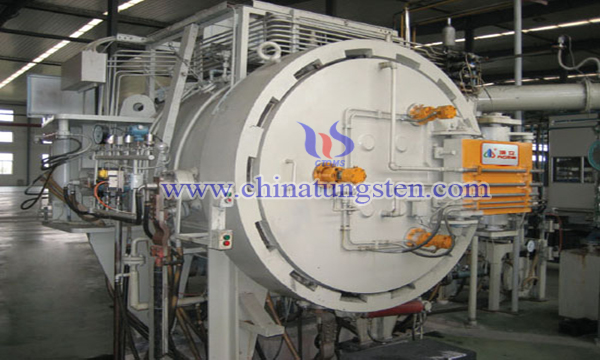Gas Recovery Cycle System for Tungsten Alloy Sintering
- Details
- Category: Tungsten Information
- Published on Monday, 09 July 2018 22:46
Researchers found that the atmosphere around tungsten alloy billets plays a key and decisive role in sintering quality during sintering. In particular, when tungsten alloys are sintered in large quantities, as tungsten alloys contain alloy additives, a large number of impurities are discharged during sintering, the greater the amount of furnace loading, the greater the impurity of the discharge and the worsening of the sintering atmosphere. The protective gas can take away a large amount of impurities produced in the sintering process and ensure the sintering quality. Therefore, on the one hand, the need for hydrogen excess to meet the requirements of sintering, on the one hand, need to reduce the amount of hydrogen to reduce the cost, which is a dilemma.

In order to solve the above problems, researchers have invented a gas recovery cycle system for a tungsten alloy sintering furnace, in which a gas is recycled, and a gas is introduced from the gas inlet of the sintering furnace during the sintering process. The gas is exhausted from the air outlet, and then the exhausted gas is sequentially passed through a heat exchanger, a purifying device, a fan, a degreasing device, a drying device, and finally re-introduced into the furnace from the air inlet.
Taking cerium tungsten alloy as an example, cerium tungsten alloy powder was pressed by cold isostatic pressing to obtain cerium tungsten alloy strip.
The cerium tungsten alloy treaty 310kg is then sintered in an intermediate frequency furnace with circulating gas. The intermediate frequency furnace is equipped with a gas purification cycle recycling system. After heating up to 1200 degrees from room temperature to normal flow (3m3/ hours) of hydrogen, when the gas flow rate is increased to 42m3/ hours after heating up to 1200, the gas purification cycle reusing system, as described in this paper, is opened until heating up to 2300. After 2 hours of heat preservation at this temperature, the flow is stopped and the flow into the gas flow is increased. The hydrogen is cooled down to 56m3/ hours, and the hydrogen is stopped until the temperature is about 100 degrees centigrade. The gas purification cycle reuse system is stopped.
After the furnace was released, the density of the finished tungsten alloy strip was ≥18.5 g/cm3, and the processing performance was found to be good after subsequent swaging or rolling. In the experiment, the nominal hydrogen amount is: ≥2.8m3/kg, and the actual hydrogen amount is: ≤0.04m3/kg. The nominal cumulative gas consumption is: the amount of gas that is introduced through the air inlet from the loading to the discharging, that is, the amount of gas consumed by the system without using the gas recovery cycle; the actual accumulated gas volume is: from loading to discharging The amount of gas actually consumed during the process, ie the amount of gas consumed by the gas recovery cycle recycling system. As can be seen, after the hydrogen recovery cycle system is used, the sintering of the tungsten product can meet the required gas protection requirements, and the hydrogen use cost can be effectively reduced.
- Tungsten Alloy Manufacturer & Supplier, Chinatungsten Online: www.tungsten-alloy.com
- Tungsten News & Prices of China Tungsten Industry Association: www.ctia.com.cn
- Molybdenum News & Price: news.molybdenum.com.cn
- Tel.: 86 592 5129696; Fax: 86 592 5129797; Email: sales@chinatungsten.com



 sales@chinatungsten.com
sales@chinatungsten.com